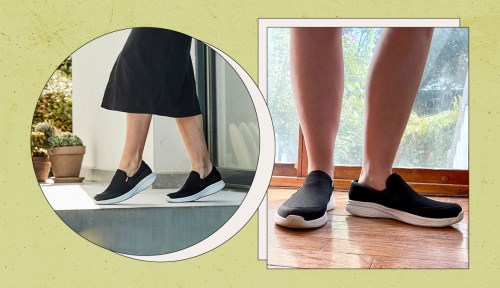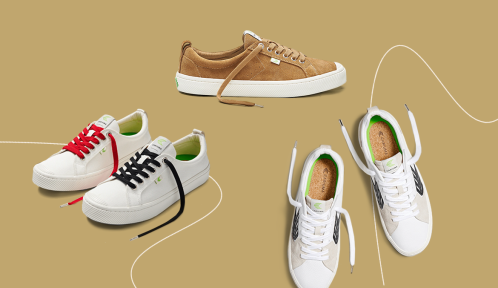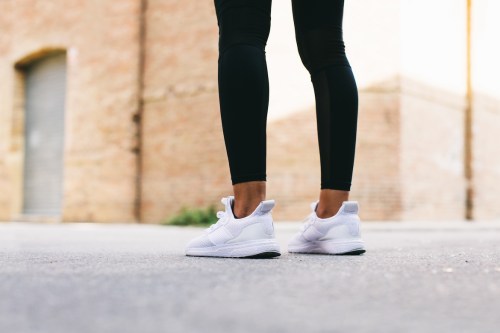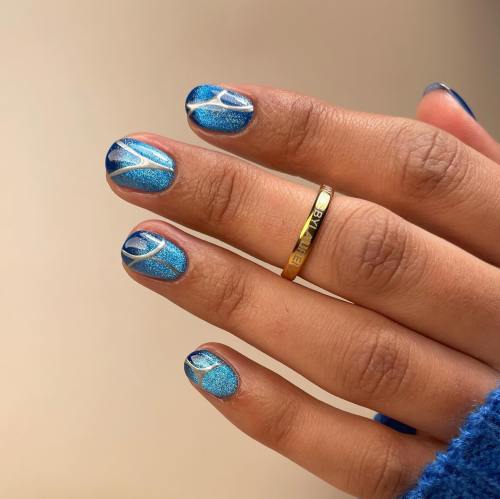Our editors independently select these products. Making a purchase through our links may earn Well+Good a commission
Growing up, I’d do just about anything to get out of tying my shoes. Remember those curly laces that twisted together so you didn’t have to tie them? Those were my jam. Slip-ons and velcro sneakers also got high marks. I knew how to tie my shoes just fine. But who wants to waste the time doing that?
Experts in This Article
podiatrist at Rocky Mountain Foot and Ankle Center in Colorado
multi-board certified podiatrist
podiatric surgeon at Sunshine Ankle and Foot Experts in Florida and a spokesperson for the American Podiatric Medical Association
These days, I’ve resigned myself to the fact that I usually do need to use laces—real ones. I don’t have any velcro on my shoe rack anymore, but I’m still a sucker for a solid slip-on.
So when I learned that MBT (for “Masai Barefoot Technology”) was launching a new iteration of its popular lightweight slip-on walking shoe, the Modena, my ears perked up. Accepted by the American Podiatric Medical Association (APMA), these kicks are built for comfort and support with a rocker bottom to propel each step forward, and they’re honestly pretty cute for “healthy” shoes. I had to try them.
MBT Modena III — $133.00
Sizes: 6-10 (women’s); 7.5–12 (men’s)Colors: 3Upper material: synthetic leather/meshFootbed: EVA foam
Pros:
- Easily slide on hands-free
- A padded heel locks your foot in place and reduces chances of blisters
- Ample cushioning to support your feet through several miles
Cons:
- Runs large
- Minor rocker bottom could cause some instability
The benefits and drawbacks of slip-on walking shoes
The convenience of slip-ons isn’t just for impatient people like me. “There are some patients that just don’t have the ability to bend over to tie their shoes, or they have maybe arthritis in their hands. And so slip-on shoes can be a nice option,” says podiatrist Brett Sachs, DPM, FACFAS, of Rocky Mountain Foot and Ankle Center in Colorado.
That said, a lack of laces can mean less stability. “The less the shoe is attached to the foot, the more variability and movement that occurs of that foot in that shoe,” points out podiatric surgeon Timothy Miller, DPM, FACFAS, DABPM, who practices at Sunshine Ankle and Foot Experts in Florida and is a spokesperson for the APMA. “The tighter the shoe is to your foot, the more support it’s going to give you.” And the ability to slide in and out hands-free means slip-ons naturally have a looser fit.
Dr. Miller also points out that slip-ons are typically designed with uppers made of elastic materials that tend to stretch out over time. “Then they don’t have that same rebound factor they once did,” he says.
About that rocker bottom
MBT is most well known for popularizing a rocker bottom sole. The idea came from Swiss engineer Karl Müller, who noticed that the Masai tribe members in East Africa who walk barefoot rarely suffer from back pain and are known for having great posture. So he designed a shoe that would more closely mimic the action of walking on soft grounds.
“Rocker shoes are shoes that have a curvature on the outer sole,” Mark Mendeszoon, DPM, a board-certified podiatrist and spokesperson for the APMA, previously told Well+Good about the rocker style. “Unlike traditional shoes, which have a flat surface, rocker shoes allow the foot to rock forward from heel strike to toe off.” This can help give you a feeling of being propelled forward with each step—which is why you’ll often find it in running shoes.
When it comes to walking shoes, this style can be particularly helpful for people who have pain in their mid-foot, points out Dr. Sachs. “It helps to allow for some better motion so that they’re not bending through the mid-portion of the foot,” he says.
Yet that curved sole doesn’t offer as much stability as a shoe that lies flat on the ground, so the rocker style isn’t a good choice for anyone with balance issues. And despite claims that the rocker encourages a more natural gait, Dr. Miller actually warns that, if it’s not medically necessary, it could change the biomechanics of walking in unhelpful ways. “It could end up causing overuse injuries because in essence, you’re [changing] the normal motion through the foot,” he says.
What the MBT Modena IIIs feel like to wear
Over the past couple of months, I’ve worn the Modenas multiple times a week on errands around the neighborhood, and walks up to five miles. The best way I can think of to describe them? They feel like supportive, cushioned slippers I can wear in the real world.
MBT describes this model as having “minor rocking,” and personally, I find the feature so subtle that I barely notice it when I’m wearing the shoes. As someone who doesn’t have balance issues, I don’t find they particularly challenge my stability. Once I’ve got my feet inside and stand up in them, the weight of my body flattens out the sole, so everything but the very back of my heel and tips of my toes ends up lying flat against the ground, with no more rocker shape than most of my running shoes.

I’m happy to report that the slip-on convenience is legit: These shoes slide on so easily, I don’t need to use my hands at all. Whether in socks or bare feet, I can quickly and smoothly put them on no matter how much my toddler is squirming in my arms as I’m trying to get us out the door.
MBT recommends sizing down half a size, and I can definitely see why—they do run big, and I have some extra room inside the shoe. Fortunately, a thick cushion around the back of the heel helps lock my feet in place so they don’t move too much when I’m out and about. Recently, though, I have started to notice that my slightly shorter foot (the right) pops up out of the heel a bit as I walk. This could be due to the upper—made of synthetic leather and mesh—losing its elasticity a bit, as Dr. Miller points out is common among slip-ons.
Still, no matter how long my walks have been, these shoes have never given me sore, irritated, or blistered feet. Honestly, my feet just feel comfy and cushioned by the EVA foam in the footbed.
If you’re not sure whether a rocker or slip-on style may work for your feet, get the advice of a medical provider who can assess how your body may respond. Personally, my feet love the Modenas—both for their comfort and their convenience.
Sign Up for Our Daily Newsletter
Get all the latest in wellness, trends, food, fitness, beauty, and more delivered right to your inbox.
Got it, you've been added to our email list.












